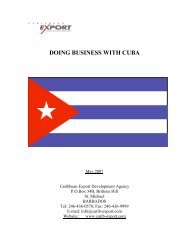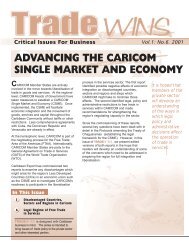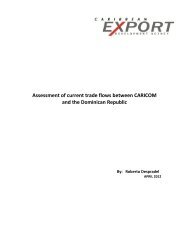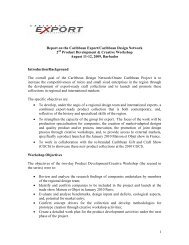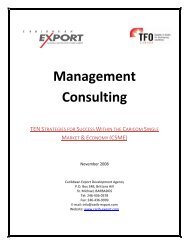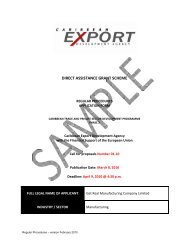The Furniture Manufacturing Industry of Barbados - Caribbean ...
The Furniture Manufacturing Industry of Barbados - Caribbean ...
The Furniture Manufacturing Industry of Barbados - Caribbean ...
Create successful ePaper yourself
Turn your PDF publications into a flip-book with our unique Google optimized e-Paper software.
itions against registration <strong>of</strong> a trademark which constitutes a geographical indication. In<br />
countries that do not specifically recognize GIs, regional trade associations may implement<br />
them in terms <strong>of</strong> certification marks.<br />
Geographical indications are particularly important in Europe, where there has been a long<br />
tradition <strong>of</strong> associating certain food products with particular regions. Under European Union<br />
Law, the protected designation <strong>of</strong> origin system which came into effect in 1992 regulates the<br />
following geographical indications: Protected designation <strong>of</strong> origin (PDO) and protected<br />
geographical indication (PGI) and Traditional Speciality Guaranteed (TSG).<br />
<strong>The</strong> system used in France from the early part <strong>of</strong> the twentieth century is known as the appellation<br />
d'origine contrôlée (AOC). Items that meet geographical origin and quality standards<br />
may be endorsed with a government-issued stamp which acts as <strong>of</strong>ficial certification <strong>of</strong> the<br />
origins and standards <strong>of</strong> the product to the consumer. Examples <strong>of</strong> products that have such<br />
'appellations <strong>of</strong> origin' include Tequila (spirits), Jaffa (oranges) and Bordeaux (wines).<br />
<strong>The</strong> consumer-benefit purpose <strong>of</strong> the monopoly rights granted to the owner <strong>of</strong> a GI also applies<br />
to the trademark monopoly right. Geographical indications have other similarities with<br />
trademarks. For example, they must be registered in order to qualify for protection, and they<br />
must meet certain conditions in order to qualify for registration. One <strong>of</strong> the most important<br />
conditions that most governments have required before registering a name as a GI is that the<br />
name must not already be in widespread use as the generic name for a similar product. Of<br />
course, what is considered a very specific term for a well-known local specialty in one country<br />
may constitute a generic term or trademark for that type <strong>of</strong> product. For example, parmigiano<br />
cheese in Italy is generically known as parmesan cheese in Australia and the United<br />
States.<br />
Like trademarks, geographical indications are regulated locally by each country because<br />
conditions <strong>of</strong> registration such as differences in the generic use <strong>of</strong> terms vary from country to<br />
country. This is especially true <strong>of</strong> food and beverage names which frequently use geographical<br />
terms, but it may also be true <strong>of</strong> other products such as carpets (eg. 'Shiraz'), handicrafts,<br />
flowers and perfumes.<br />
International trade made it important to try to harmonize the different approaches and standards<br />
that governments used to register GIs. <strong>The</strong> first attempts to do so were found in the<br />
Paris Convention on trademarks (1883), followed by a much more elaborate provision in the<br />
1958 Lisbon Agreement on the Protection <strong>of</strong> Appellations <strong>of</strong> Origin and their Regitration.<br />
Few countries joined the Lisbon agreement, however: by 1997 there were only 17 members<br />
(Algeria, Bulgaria, Burkina Faso, Congo, Cuba, Czech Republic, France, Gabon, Haiti, Hungary,<br />
Israel, Italy, Mexico, Portugal, Slovakia, Togo, Tunisia). About 170 geographical indications<br />
had been registered by Lisbon Agreement members as <strong>of</strong> 1997.<br />
<strong>The</strong> essential function <strong>of</strong> a trademark is to exclusively identify the commercial source or origin<br />
<strong>of</strong> products or services, such that a trademark, properly called, indicates source or serves<br />
as a badge <strong>of</strong> origin. <strong>The</strong> use <strong>of</strong> a trademark in this way is known as trademark use, and a<br />
trademark owner seeks to enforce its rights or interests in a trademark by preventing unauthorized<br />
trademark use.<br />
It is important to note that trademark rights generally arise out <strong>of</strong> the use and/or registration<br />
(see below) <strong>of</strong> a mark in connection only with a specific type or range <strong>of</strong> products or services.




